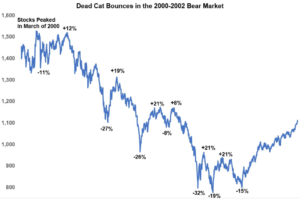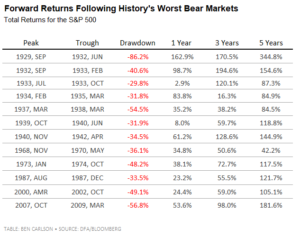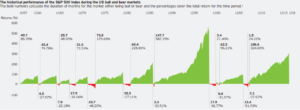April 3, 2020
We crafted a letter a little over a week ago, which we never sent. The theme of the letter was to hold strong during these emotionally charged times. At that point, the stock market, after many scary and turbulent days found itself down 34% in just a few weeks.
In that letter, we mentioned that “this is the moment we need to stay strong and not give in to our strong tendency to want to sell our stocks. When the recovery comes, it comes quickly.”
Well, the recovery came quickly alright, the day after we wrote that letter, the stock market posted its largest daily return in history, and then another big day came after that, and then another, all the way to a 20% advance in three days.
There is no doubt that we are in a bear market now (defined as a 20% decline off the highs). We thought now would be a good time to give you a brief reminder on how bear markets work. Keep in mind that every bear market is different, but there are a lot of similarities.
Here are a few statistics on bear and bull markets:
BEAR MARKETS
-
- Average length of bear market: 11.7 months
- Average loss in bear market: (-34.33%)
BULL MARKETS
-
- Average length in bull market: 1 months
- Average gain in bull market: 71%
It’s important to remember that bear markets happen. They are completely normal, and as we are all finding out, they can be unsettling if not downright scary. We hope that after you read this, it will help a bit with the anxiousness we are all experiencing.
The graphic below depicts the 2000-2002 (dot.com) bear market. Look at the number of market rallies and declines over the extended bear market.
This is not to say we will have identical market gyrations as the chart above, but we will certainly see many in the months to come. So, we all need to be prepared emotionally for the ups and downs, as well as the shocking news headlines that are coming.
Rest assured; we will be prepared on our side.
When we eventually emerge from this bear market, and begin the next bull stage, investment returns could be spectacular, and they will happen quickly. In fact, average returns following bear markets have been 52% (over 1 year), 89% (over 3 years), and 132% (over 5 years).
The graphic below shows the last 12 bear markets. It shows how much they declined from top to bottom (drawdown) and what their subsequent returns were.
Here is another way to look at how often bear markets occur and their over length of time compared to bull markets.
In closing, we are fully aware we are all living in an unprecedented time, both from a health and an economic perspective. But it appears the country is really starting to step up in its battle against Covid-19. The federal government has pulled out all the stops to help combat the economic challenges ahead. Over $2 trillion in fiscal rescue funds have been allocated, plus another $4 trillion in loans from the Federal Reserve are ready to be deployed if necessary. This is triple the overall stimulus that was used in the Great Recession.
Banks are in a much better position than they were during the Great Recession, with only one-third the leverage. However, we have begun to see some cracks in the high-yield or “junk bond” area, which thankfully, we do not own in any of our portfolios.
Be prepared, the headlines are going to be ugly in the weeks to come. Nearly 10 million people have applied for unemployment benefits in the last two weeks, and there will be many more. This is going to take some time, but we will come out the other side eventually. In the interim, we will do our best to make smart investment and trading decisions.
We are here for you at any time (from our remote offices). Thank you for your continued trust and support.
-RS Crum




